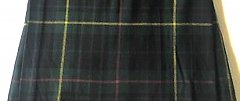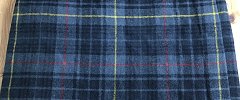X Marks the Scot - An on-line community of kilt wearers.
|
-
17th October 20, 09:48 AM
#1
9th Royal Scots kilts
        Hello members, Hello members,
I have copied this over from the Great War Forum as I hope
you might have the answers I seek. Has anyone here ever noticed an anomaly in the way RS kilts have been made over the years? Have a look at the images attached. Unlike all the other regiments, the RS seem to have drifted between yellow stripe to centre, red stripe to centre and even the fabric turned to 90 degrees! Look very closely at the pattern. Hunting Stewart is unusual in that:
’the half sett is not reversed to create a symmetrical square. Instead the full sett is simply repeated from right to left across the cloth.’
Which is why it matters which direction the cloth is used. You can’t turn it 90 degrees and have the yellow or red stripes in the same place. With Government Tartan for instance, you can use it in any direction. Bizarre!
Last edited by HTTC; 17th October 20 at 10:01 AM.
Reason: Forgot images!
-
-
18th October 20, 09:02 AM
#2
The differences in sett size and colour shades suggests that these kilts are from different periods. Of the 8, 5 have the yellow stripe centred (bisected by the sporran), 2 have the red centred (visually this is better IMO). The final one looks to have the yellow slightly off-centre but that might just be the photographic angle.
Are these all RS kilts and if so, are they all from the 9th (Highlanders) Bn? And if so, are the all ORs’ kilts? I can’t remember which regiment it was that had a different centre stripe for the Officers’ and Soldiers’ kilts. Or different Bns perhaps? Dress Regs of the time should have specified how the pattern was to appear on the font apron.
Yes, the Hunting Stewart is asymmetric but that is not why it cannot be turned 90 degrees and used for kilting. The same would apply to any tartan because turning it thus would mean joining sections of material and would also mean the loss of the selvedge.
-
The Following User Says 'Aye' to figheadair For This Useful Post:
-
19th October 20, 02:04 AM
#3
 Originally Posted by figheadair

I can’t remember which regiment it was that had a different centre stripe for the Officers’ and Soldiers’ kilts.
The Gordon Highlanders.
-
The Following User Says 'Aye' to blackwatch70 For This Useful Post:
-
19th October 20, 02:28 PM
#4
 Originally Posted by figheadair

Are these all RS kilts and if so, are they all from the 9th (Highlanders) Bn? And if so, are the all ORs’ kilts?
Yes these are all RS kilts. Which other battalion other than the 9th wore kilts?
Yes, the Hunting Stewart is asymmetric but that is not why it cannot be turned 90 degrees and used for kilting. The same would apply to any tartan because turning it thus would mean joining sections of material and would also mean the loss of the selvedge.
Either the fabric is used back to front in some instances pictured here or the fabric has been woven at 90 degrees to the other setts.
-
-
20th October 20, 12:48 AM
#5
 Originally Posted by HTTC

Either the fabric is used back to front in some instances pictured here or the fabric has been woven at 90 degrees to the other setts.
Because the sett is asymmetric there are two possible way to lay out the cloth; what I have called the normal way (with the red stripe first in the sequence after the thin green). In the reversed or 180-degree rotation the yellow comes first. Turning 90 degrees clockwise or anti-clockwise simply repeats the normal and reverse appearance.
The other thing about an asymmetric pattern is that the pattern will differ on the left and right selvedge. Most military cloth has been double-width for well over 100 years meaning that for a given length, half the kilts will have one selvedge, the other half the other one. For the Hunting Stewart tartan that means that half the kilts would have the red nearer the selvedge and for the other half it would be the yellow.
Looking that the 8 kilts posted, 3 are made with the normal setting and 5 with the reserved setting. I would guess that the difference in these kilts, besides the obviously difference weavings, is that it was simply a case of the quartermaster needing to used the whole cloth and not just half of it.

-
The Following User Says 'Aye' to figheadair For This Useful Post:
Tags for this Thread
 Posting Permissions
Posting Permissions
- You may not post new threads
- You may not post replies
- You may not post attachments
- You may not edit your posts
-
Forum Rules
|
|
Hello members,


















Bookmarks